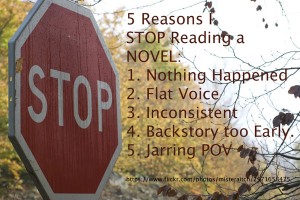Your opening line needs to encourage readers to continue on with your story.
http://writersinthestormblog.com/2016/09/nail-that-first-line-2/
Viewing: Blog Posts Tagged with: openings, Most Recent at Top [Help]
Results 1 - 25 of 54
Blog: Just the Facts, Ma'am (Login to Add to MyJacketFlap)
JacketFlap tags: openings, Add a tag
Blog: Just the Facts, Ma'am (Login to Add to MyJacketFlap)
JacketFlap tags: series, openings, Add a tag
How do you bring new readers up to date without boring those who are familiar with your series?
http://kidlit.com/2016/09/19/series-beginnings/
Blog: Just the Facts, Ma'am (Login to Add to MyJacketFlap)
JacketFlap tags: openings, Add a tag
One amazing first sentence can be enough to hook your reader.
https://leslieleibhardtgoodman.wordpress.com/2016/09/12/nine-ways-to-hook-your-reader-with-a-powerful-opening-sentence/
Blog: Just the Facts, Ma'am (Login to Add to MyJacketFlap)
JacketFlap tags: openings, Add a tag
Here are five suggestions for writing a first page that will draw in your readers.
http://diannematich.com/2016/08/five-tips-for-your-first-page/
Blog: Just the Facts, Ma'am (Login to Add to MyJacketFlap)
JacketFlap tags: openings, Add a tag
What do editors look for when they begin reading your story?
http://authornews.penguinrandomhouse.com/what-our-editors-look-for-on-an-opening-page/
Blog: Just the Facts, Ma'am (Login to Add to MyJacketFlap)
JacketFlap tags: openings, Add a tag
Draw readers into your story by avoiding these beginnings.
http://nelsonagency.com/2016/06/new-article-series-9-story-openings-to-avoid/
http://nelsonagency.com/2016/07/9-story-openings-to-avoid-part-2/
Blog: Just the Facts, Ma'am (Login to Add to MyJacketFlap)
JacketFlap tags: openings, Add a tag
There are several things you need to accomplish in the first few pages of your novel.
http://www.adventuresinyapublishing.com/2016/06/four-essential-elements-for-your-first.html
Blog: Just the Facts, Ma'am (Login to Add to MyJacketFlap)
JacketFlap tags: openings, Add a tag
Here are some common problems seen in the first five pages of a manuscript.
http://www.adventuresinyapublishing.com/2016/06/10-writing-pitfalls-from-mentors-of-1st.html#.V3Ayh7grJlY
Blog: Just the Facts, Ma'am (Login to Add to MyJacketFlap)
JacketFlap tags: openings, Add a tag
Here are some things to avoid in the opening pages of your novel.
https://warriorwriters.wordpress.com/2016/05/31/botched-beginnings-common-first-page-killers/
Blog: Just the Facts, Ma'am (Login to Add to MyJacketFlap)
JacketFlap tags: openings, Add a tag
There are many techniques to craft a first line that will pull in your readers.
http://writersinthestormblog.com/2016/01/nail-that-first-line/
Blog: Just the Facts, Ma'am (Login to Add to MyJacketFlap)
JacketFlap tags: revisions, openings, Add a tag
Here's a checklist to help you revise that oh-so-important first chapter.
http://annerallen.com/2016/01/how-to-start-novel-checklist-for.html
Blog: Just the Facts, Ma'am (Login to Add to MyJacketFlap)
JacketFlap tags: openings, Add a tag
Here are some hints about how to and how not to begin your novel.
https://kathytemean.wordpress.com/2015/09/30/starting-your-novel-nine-dos-and-donts/
Blog: Just the Facts, Ma'am (Login to Add to MyJacketFlap)
JacketFlap tags: openings, Add a tag
Does your book need a prologue or are you just using one for an infodump?
http://scotteagan.blogspot.com/2014/12/to-prologue-or-not.html
Blog: Just the Facts, Ma'am (Login to Add to MyJacketFlap)
JacketFlap tags: writing, openings, Add a tag
How can you write the "perfect" first chapter?
Blog: Just the Facts, Ma'am (Login to Add to MyJacketFlap)
JacketFlap tags: openings, Add a tag
Follow this checklist and make your openings pop.
http://writersinthestormblog.com/2014/11/margies-rule-6-make-your-opening-pop/
Blog: Darcy Pattison's Revision Notes (Login to Add to MyJacketFlap)
JacketFlap tags: novel, how to write, openings, Novel Revision, start, Add a tag
PB&J: Picture Books and All That Jazz: A Highlights Foundation Workshop
Join Leslie Helakoski and Darcy Pattison in Honesdale PA for a spring workshop, April 23-26, 2015. Full info here.COMMENTS FROM THE 2014 WORKSHOP:
- "This conference was great! A perfect mix of learning and practicing our craft."�Peggy Campbell-Rush, 2014 attendee, Washington, NJ
- "Darcy and Leslie were extremely accessible for advice, critique and casual conversation."�Perri Hogan, 2014 attendee, Syracuse,NY
Openings are incredibly important. This was brought back to me recently as I was judging a contest. Those manuscripts that kept my interest for three pages were rare. Usually, they lost me by the middle of page two!
Am I harsh? I don’t think so.
Grab the Reader with Your Opening Lines
Noah Lukeman has it right in his book, The First Five Pages: A Writer’s Guide to Staying Out of the Rejection Pile. This is a book I ask those attending my Novel Revision retreats to read before they attend. Lukeman’s premise is that an editor will decide if they want your book or not based on the first five pages of your manuscript. After judging this contest, I agree. Sometimes, you can even make a judgment based on the first paragraph.
That first paragraph? You want to grab the reader by the throat and never let go!
Here are five things that made me stop reading
- Nothing happened. The whole first chapter could be cut, because no major action occurred. Ask yourself: what happened in this chapter? Is there any conflict here?
- The voice was flat. Monotone and uninteresting. Read it aloud: Does the text demand that you use an interesting variation of pitches, tones, stops, starts, etc?
- Inconsistencies. If I found myself thinking, “No, that couldn’t happen. Not that way,” then the story was in trouble. Consider: does the story logic work?
- Backstory. Please don’t put backstory in the first chapter. Give us an active scene with the character in motion and wanting something. It doesn’t have to be the major goal of the book, but the character needs to want something and it should be something that leads into the main conflict. Ask yourself: Do I really need to explain the backstory here, or can I wait until page 100? Yes! Page 100! Move that stuff out of the first act entirely!
- The point-of-view jumps out at me. Too many of the mss had first-person point-of-views that just jumped out at me and made me cringe. In other words, the voice wasn’t distinctive enough for first person. This is a personal opinion–FWIW–but I think too many people are trying to write a first-person narrative. The default should be third-person unless there is a compelling reason for first. It’s not just a bias against first-person, but rather, that the story would be better served from third in many cases.
There were some first-person stories where I didn’t even realize it because the story caught me. When it works, it work well. When it fails, the story might could be salvaged by a switch to third. Consider: Is there a compelling reason for the first-person point-of-view? Could this ONLY be told from first? Try–OK, just try–writing the first chapter from third and give it to an independent, unbiased reader (like you can find that!) and ask which version they like better (don’t tell them what the difference is). I bet that third will win in the majority of cases.
Blog: Just the Facts, Ma'am (Login to Add to MyJacketFlap)
JacketFlap tags: openings, Add a tag
These scenes might not be the best to choose for your opening.
http://annerallen.blogspot.com/2011/09/13-ways-not-to-start-novel.html
Blog: Just the Facts, Ma'am (Login to Add to MyJacketFlap)
JacketFlap tags: openings, Add a tag
Ten things your opening chapter should do.
http://annerallen.blogspot.com/2013/06/10-things-your-opening-chapter-should.html
Blog: Just the Facts, Ma'am (Login to Add to MyJacketFlap)
JacketFlap tags: openings, Add a tag
Ten things your opening chapter should do.
http://annerallen.blogspot.com/2013/06/10-things-your-opening-chapter-should.html
Blog: Just the Facts, Ma'am (Login to Add to MyJacketFlap)
JacketFlap tags: openings, middle_grade, young_adult, Add a tag
Here are a few things not to put in your opening pages.
http://annerallen.blogspot.com/2014/07/how-not-to-start-novel-four-things-to.html
Blog: Just the Facts, Ma'am (Login to Add to MyJacketFlap)
JacketFlap tags: openings, Add a tag
A group of agents give advice on writing the first pages of a novel.
http://chasingthecrazies.wordpress.com/the-f3/
Blog: The Bookshelf Muse (Login to Add to MyJacketFlap)
JacketFlap tags: What Killed it For Me, Uncategorized, Openings, Add a tag
It’s likely that we’ve all encountered these stories—the ones that open with an explosion, plague, car chase, alien abduction, fist fight, or other volatile scene involving a main character that we know virtually nothing about. I get why authors do this. It makes sense that starting the story with a bang would engage readers and suck them right in. But most of the time, the opposite happens for me: I end up confused and uninterested. And here’s why: To care about what’s happening to the character, I have to first care about the character.
To care about a hero, readers need to know what he wants and what’s at stake if he doesn’t get it. They’ve also got to respond to him emotionally on a certain level if they’re going to empathize with him and his circumstances. Readers need to have a feel for this stuff before the main character gets thrown into the arena or accused of espionage. If the cart comes before the horse here, it’s highly likely that readers won’t engage and may not continue reading.
So how do we avoid this problem in our own writing?
1. Don’t start with the main action. We need to see the character in her real world before the main conflict arises. This provides contrast, pitting the old safe-but-somehow-unsatisfactory world against the crazy new one. It also gives us a chance to get to know the hero before her world is turned upside down. So if your story is about people surviving an ebola outbreak, don’t open with the hero’s mother bleeding from the eyes. If it’s about a woman living in the aftermath of divorce, don’t open with her husband leaving her. Give readers a chance to care about the hero before the main conflict arises, and readers will be more inclined to stick around to see what happens to her.
2. Avoid gimmicky opening action sequences. I made this mistake in one of my first novels. My book opened with the main character running through a field, breathing heavily and casting frantic looks over her shoulder. Readers assumed she was being chased, and she was. But when it turned out she was just playing hide-and-seek, they were not amused. The opening came across as contrived, which is fitting, since that’s exactly what it was. Readers are smart. They know when they’re being deceived or manhandled, and like anyone with any sense, they don’t like it at all. (This is one of the reasons why opening dream sequences rarely work.)
The thing is, enthralling stories that suck readers in don’t have to start with action. Look at The Hunger Games. Talk about action-packed—yet, it opens with the main character waking up. Collins could have opened her book at half-a-dozen later points in the story, and there would have been a lot more going on. But those openings wouldn’t have worked, imo, because they weren’t the right place to start her story. And that brings us to something super important that you have to do…
3. Start your story in the right place. I’ve heard it said that you should start your story just before the protagonist’s life intersects with the antagonist’s agenda. The Hunger Games is a great example. President Snow’s agenda is to strengthen his control over the people of Panem via the hunger games. Katniss has been to the reaping a number of times, but because her name hasn’t been called, her life hasn’t yet intersected with Snow’s agenda. That doesn’t happen until Prim’s name is picked. Had Collins started the story after that, the opening would have been jarring and probably confusing for readers. Had she started much earlier than she did, the opening would have dragged.
Finding the right starting point is critically important in engaging readers early. Locate that magical point where the antagonist’s agenda intersects with the hero’s life. Open your story just before that collision, and you’ll likely be starting in a spot that will resonate with readers.
Photo credit: The Official CTBTO Photostream @ Creative Commons
The post What Killed it For Me #6: Action Too Early appeared first on WRITERS HELPING WRITERS.
Blog: Just the Facts, Ma'am (Login to Add to MyJacketFlap)
JacketFlap tags: writing, openings, Add a tag
As the saying goes, you only have one chance to make a good first impression.
http://www.adventuresinyapublishing.com/2014/03/inspired-openings-make-your-first.html
Blog: The Bookshelf Muse (Login to Add to MyJacketFlap)
JacketFlap tags: Openings, What Killed it For Me, Add a tag
Happy spring everyone! Those of you who live up north, please don’t hurt me. To be honest, there’s really no difference in the weather between spring and winter where I live, so it shouldn’t be such a big deal to me. But last week was Spring Break—my first real one in years. When I had kids at home, people would be all Woohoo! It’s Spring Break! And I was all Really? Then why are my kids still waking me up at 6:30? But my daughter is in kindergarten now, and last week, we did get get to sleep in, and go bowling and to the beach and to the park and to every fast food restaurant in town—all without any real schedule to speak of. It. Was. AWESOME.
So, happy Spring, everyone! If you haven’t seen it yet, it’s coming, I promise :).
And now, for the latest book I gave up on. This one was a fantasy and there were like five books in the series, so I figured it would probably be good. And it was very promising. But it was also very confusing. Set in a make believe world, it was based on a unique and fantastical element, contained an involved political hierarchy, a main character who didn’t know who he was or where he’d come from, and two separate point-of-view characters whose stories seemed to be unrelated.
Now, because fantasy is by far my favorite genre to read, I’m used to magical elements and complicated caste systems and too many characters. But this one was just too much. As I read it, my brain was trying to figure out the political system, and where the hero fit into it, and who he really was, and how the magical element worked. And what was with the second narrator? Where did she fit in?
I see this problem sometimes with fantasy and sci-fi. I write mostly fantasy, and I have this problem myself. The author tries to make things so unique that the reader has to focus too much on assimilating new information and she can’t enjoy the story. But there are ways to introduce a whole new world—even one that needs explanation—in a way that won’t confuse readers.
City of a Thousand Dolls is a book that does this very well. In this story, there’s a rigid social/political caste system, a school for abandoned girls with its own separate hierarchy, talking cats, and shape-shifting characters who can turn into different animals. This story could easily be confusing and off-putting. Instead, it’s deeply engaging with an incredibly strong sense of place. Here are some ways that Miriam Forster introduces her fantasy world without overwhelming readers:
1. Introduce new elements slowly. It takes awhile for readers to assimilate new information. If you throw too much at them at once, their brains can’t keep up and they either shut down and quit reading or they miss important information that will cause confusion later. Space out the introduction of new information so readers aren’t overwhelmed. Don’t try to jam it all into the first chapter.
2. When possible, show unique elements instead of telling them. Many fantasy writers make the mistake of stopping the story to explain some of the unknown bits. This kind of telling, especially at the beginning of a story, should be avoided because a) it drags the story to a halt while the author stops to explain stuff, and b) it further slows the reader’s progress because she’ll have to pause later on to assimilate the given information into the current story. Instead of telling or explaining new elements, introduce them through the context of the current story.
One of the unique elements in City of a Thousand Dolls is something called an asar. To show what it is, Forster references it in context, and the reader is able to figure it out without even slowing down: Her satisfaction lasted only as along as it took for a group of girls to decide she was an easy target in her plain gray asar and untidy braid. And a few paragraphs later: She could imagine the House Mistress perfectly, her rust-brown asar wrapped so it came only to her knees, the short sword at her side. With these two context clues, the reader gets an adequate idea of what an asar is without having to interrupt the story to figure it out. When it comes to fantastical elements, show whenever you can.
3. Don’t Reinvent the Wheel. As a fantasy author, I know our tendency to go a little crazy with the world building. We’re so into our new world and its uniqueness that we come up with new inventions and new names for everything. But too much of this becomes tiring for readers. If you have a unique element, make sure it’s necessary. Forster’s asars play an important part in the story because they designate which house each girl belongs to. Through this article of clothing, she avoids having to identify each girl’s house when the girls are introduced. So think carefully before coming up with a new form of lighting, time telling, transportation, or messenger service. Keep the unique components that add to your story and stick with what already works for the rest. (For more tips on creating a believable setting, see this post on World Building Rules and Elements).
4. Simplify. Sometimes it’s not just the cool elements that we tend to overdo. It’s the plot line, setting, family history, political structure, etc. In many cases, these things can be simplified without taking anything away from the story. To see if your overall story has got too much going on, summarize it. If you can do so succinctly and listeners aren’t confused, then you should be able to write it in a way that readers will understand. If you share your summary and listeners have to ask questions to clarify, you either haven’t summarized it well or you’ve got too much going on. See what can be removed or pared back so the amazingness of your story can shine through instead of being overwhelmed. An added benefit of summarizing your plot line or setting is that it shows you what’s important. Whatever’s included in your summary should be introduced and clarified first. Then you can move on to the other stuff.
So, have you read any other-worldly books that were fully believable? What techniques did the author use to make the whole thing work? And if you missed the first two posts in this series, you can find them here and here.
The post What Killed It For Me #3: Too Much Going On appeared first on WRITERS HELPING WRITERS.
Blog: The Bookshelf Muse (Login to Add to MyJacketFlap)
JacketFlap tags: Openings, What Killed it For Me, Add a tag
For my first post in this series, I focused on a common reason that readers might stop reading: Lack of a Clear Goal. If the main character doesn’t have a goal, or if it’s not revealed early on, readers don’t know where the story’s headed and may end up losing interest.
Today, I’m going to talk about a problem I ran into just last week. I was browsing the library shelves and came across a book I’d never read by one of my favorite authors when I was a teen. It was a companion novel to a series I’d devoured—the paperbacks are literally falling apart on my bookshelf at home. Needless to say, before I’d read a single word, I was fully prepped to love this book.
Sadly, I didn’t.
The main character was mentioned in the original series but never made an appearance. Now I know why. He was surly, incredibly cocky, apathetic to the feelings of others, mean to a homeless dog that kept turning up, and had a chip on his shoulder the size of Texas. Granted, he had a good reason for being so crabby. This, combined with my desire to love the story, kept me reading far longer than I normally would have. But by chapter four, I gave it up.
Character creation is tricky. Our heroes have to have flaws, but they can’t be so flawed that people would rather abandon them than share the journey. A book that achieves this balance flawlessly is one of my favorite reads of 2013: The Wicked and the Just. The story is incredibly well-written, but I also love it because it contains the most unlikable character I think I’ve ever read. And yet I cared about what happened to her. I not only finished the book, I now haunt the author’s website looking for the sequel. When I deconstruct Coats’ writing, I see some techniques she utilized to make her unlikable character not only bearable, but endearing:
High Stakes. The year is 1293, and Cecily’s father is moving them to occupied Wales, where tensions between the ruling English and subdued Welsh are high. It’s clear from the beginning that serious trouble is coming and Cecily will be smack in the middle of it. Though a character may be unlikable, readers can still empathize with her if her circumstances are dire. That danger doesn’t have to be physical, though. Circumstances that threaten a character’s emotional or mental wellbeing can be just as gripping. Look at John Nash from A Beautiful Mind. Whatever’s at stake, make sure it’s big and it’s clear, and readers may still root for an unlikable character.
Endearing Traits. Certain character traits are nearly universally admired by others: intelligence, wit or humor, feistiness. Cecily’s voice conveys all of these things. Though she’s selfish, manipulative, and sometimes mean, you’re drawn in because she’s funny, and though you don’t approve of her methods, you have to admire her for striving so hard for what she wants. To make a difficult character more palatable, give her some likable qualities, and readers just might buy in.
An Endearing Moment. Though Cecily’s admirable qualities are evident in her narrative, I don’t think that an entertaining voice is enough. Coats remedies this on page four by including a brief conversation between Cecily and two friends that reveals how brokenhearted they all are that Cecily is leaving. Though her good qualities are understated, the affection of her friends shows that someone truly likes her—that she’s worth liking. It’s downplayed, but it’s a classic Save The Cat moment. Show your character doing something likable or being likable in some way, and the reader will see that she’s not a lost cause.
One caveat: I’ve always believed that the main character has to be likable in some way for readers to make that magical connection. But after thinking on this for awhile, I think I’ve changed my tune. I mean, Scarlett O’Hara wasn’t likable at all. Will Hunting: not exactly a charmer. But these characters resonate with audiences. Why? Because they evoke an emotion that endears them somehow to audiences: they make them laugh, or elicit admiration, or evoke sympathy.
So if you’ve got a character that’s hard to love, utilize one or more of these techniques to draw out those endearing emotions, and you just might ensure that readers will keep on reading.
The post What Killed it for Me #2: Characters Who Aren’t Endearing appeared first on WRITERS HELPING WRITERS.
View Next 25 Posts









